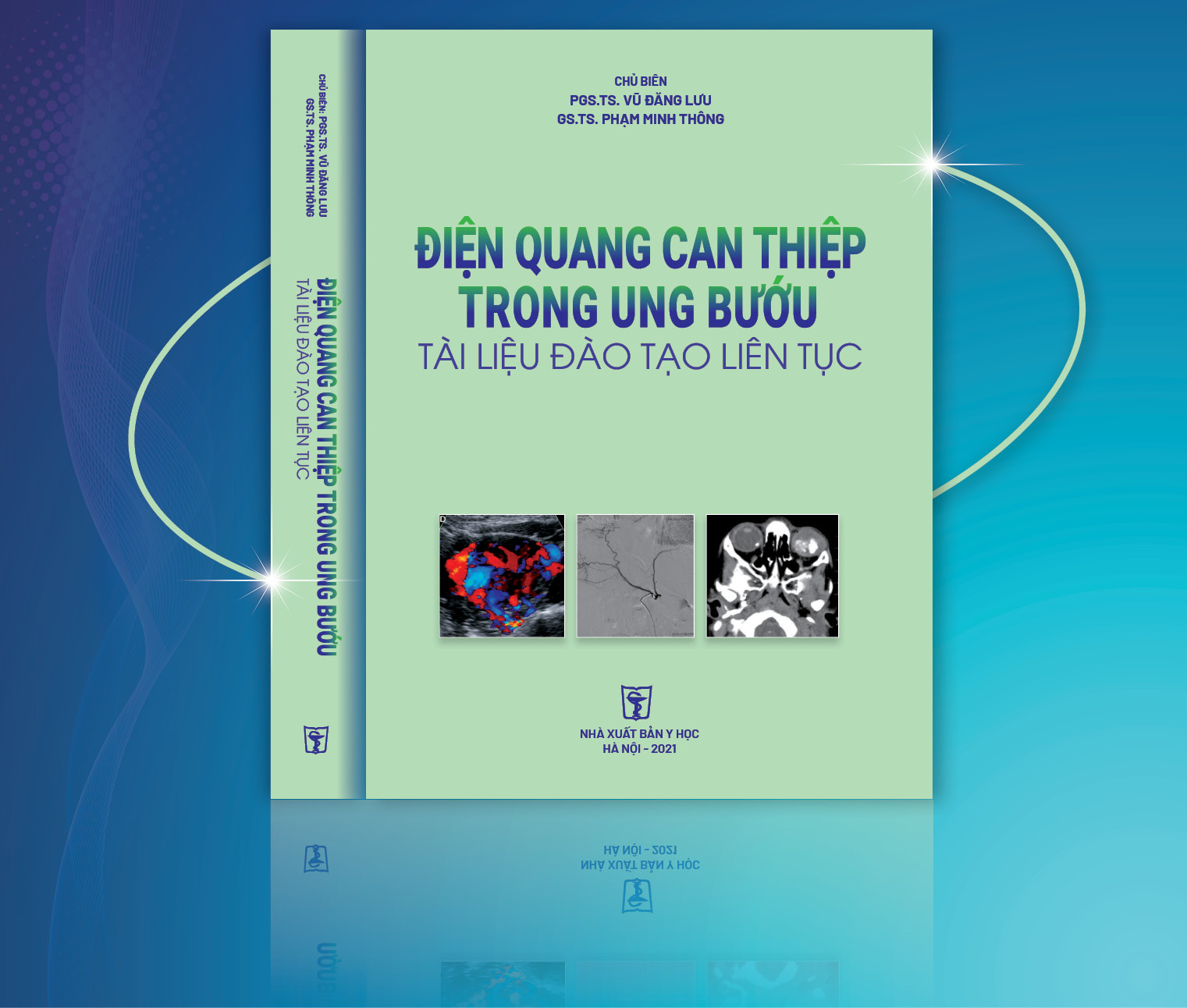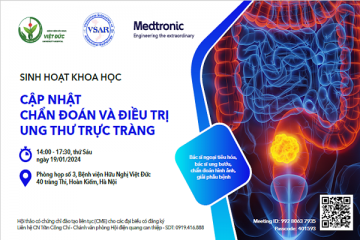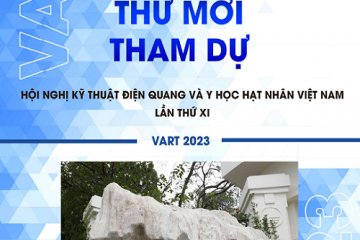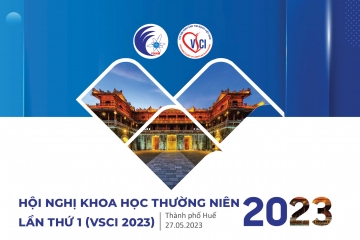
Nghiên cứu đặc điểm hình ảnh và giá trị của cộng hưởng từ 1.5 Tesla trong đánh giá sống còn cơ tim ở bệnh tim thiếu máu cục bộ
31/03/2020 16:00:33 | 0 binh luận
Imaging characteristics on and value MRI of myocardial viability in patients with chronic ischemic heart disease summary Purposes: 1. To describe the imaging characteristics on CMR of myocardial viability in patients with chronic ischemic heart disease; 2. To define the relationship between myocardial viability on magnetic resonance imaging (MRI) with the stenosis degree of coronary artery on invasive coronary angiography (IVA). Materials and Methods: 37 patients with chronic ischemic heart disease were enrolled in this cross-sectional prospective study. All patients were performed cardiac MRI and IVA during a period from 12/2011 to 8/2012 at Bach Mai Hospital. The data analysis by using the SPSS 18.0 (Chicago, United States). Results: 37 patients/ 27 males (73%) with mean age: 60.11 ± 11.74 year (35 - 81). Mean left ventricular systolic function (EF): 45.83 ± 12.83% (ranged 16.6 - 72%). 64.9% had EF decreased moderate to severe. 73% had reduction of ventricular contraction. 35 patients (94.6%) had late enhancement, of which 67.6% segments supplied by LAD, 64.8% had extent myocardial scar > 50%. Sensitivity and specificity of late enhancement at coronary artery stenosis ≥ 50% were 97.1%, 33.3% respectively. Conclusion: The extent of myocardial scar had good relationship with the stenosis degree of coronary artery. Key word: Cardiac MRI, Chronic ischemic disease, coronary artery.
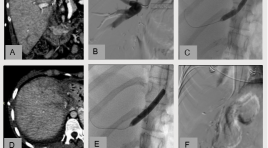
Điều trị can thiệp nội mạch hẹp tĩnh mạch gan sau ghép gan từ người cho sống ở trẻ em: Nhân một trường hợp
15/04/2020 20:54:05 | 0 binh luận
Endovascular treatment of hepatic vein stenosis following liver transplant in a child: a case report SUMMARY Liver transplantation is the major therapeutic option for end-stage liver disease as recent improvement in surgical technique, immune-suppressant contribute to better post-transplant outcome. However, significant graft failure as a result of vascular complications is still noted, especially in partial liver transplant with living donor graft and complications is higher risk in children compared with adults. The incidence of hepatic vein stenosis in pediatric liver transplant is 6% with living donor graft. A first case of pediatric liver transplant with living donor graft which performed in Viet Duc hospital have complication of hepatic vein stenosis and success with balloon angioplasty and stent placement. Key word: Living donor transplants, hepatic vein stenosis.
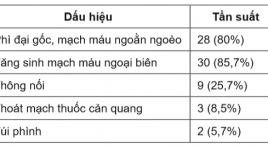
Vai trò can thiệp nội mạch trong điều trị ho ra máu nặng
14/04/2020 23:19:28 | 0 binh luận
The role of endovascular treatment for massive hemoptysis SUMMARY Objectives: To assess the safety and effectiveness of arterial embolization in patients with massive hemoptysis. Subjects and Method: All patients were diagnosed massive hemoptysis and treated endovascular intervention in Cho Ray Hospital from January 2016 to March 2017. Some variants were asscessed: etiologies, important angiographics findings, the clinical success, complications and follow-up outcomes within 1 month. Results: 35 patients were treated by endovascular intervention. Massive hemoptysis was caused by bronchiectasis (37,1%), pulmonary tuberculosis (20%), pulmonary aspergilloma 14.3%). A total of 69 bleeding arteries were found, an average of four arteries per patient. Important angiographics findings were: vascular hypertrophy and tortuosity (80,0%), neovascularity and hypervascularity (85,7%), shunting (25,7%), aneurysm formation (8,5%) and active extravasation (5,7%). Immediate clinical success achieved was 97,1% (34/35 patients) and 11,7% of patients had recurrent over 1 month; aspergilloma and shunting were asociated with early recurrent (p<0,05). No serve complications were reported and the most common complication was trasient chest pain (28,6%). Conclusion: Endovascular treament is an effective and safe procedure in the management of massive hemoptysis. Keywords: massive hemoptysis, embolized arteries, clinical success, early recurrent.
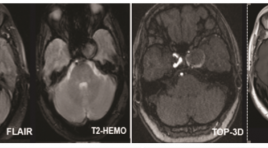
Kết quả bước đầu can thiệp nội mạch điều trị phình động mạch não lớn và khổng lồ bằng STENT thay đổi dòng chảy tại bệnh viện Chợ Rẫy
14/04/2020 23:08:55 | 0 binh luận
Initial results of endovascular neurointervention using flow - diversion stent for treatment of large and giant intracranial aneurysms at Choray Hospital SUMMARY Objectives: Currently, interventional neuroradiology using coiling technique for embolization of intracranial aneurysms has been becoming a standard method, can be an alternative method for surgical clipping. However, for wide-necked, fusiform, dissecting and giant aneurysms, incomplete occlusion and recanalization were still main limitations for long-termed outcomes. The development of flow-diversion stents has been leading to the possibility of complete occlusion of aneurysms due to change of blood flow into aneurysms, resulting in thrombogenesis inside the aneurysms. Subjects and methods: Interventional neuroradiology using flowdiversion stent performed at Department of Radiology, Choray Hospital, from 01/2015 to 06/2017, the technique as follows: digital subtraction angiography, inserting of mirocatheter over the aneurysm neck, deploying the flow-diversion stent over the aneurysm neck. The efficacy and safety were evaluated by variants: complete and partial occlusion rates, procedural success rate, clinical improvement, procedural complication. Results: 24 cases of large and giant intracranial aneurysms treated with flow-diversion stents, technical success rate 21/24 (87.5%), 03 cases failed to be performed had to change to other treatment or follow-up, 01 case of abrupt death during follow-up. Conclusion: Using flow – diversion stent is a new technique, may be effectively alternative method compared to conventional aneurysmal coiling, especially in treatment of large and giant intracranial aneurysms. Key words : Large and giant intracranial aneurysms, flow – diversion stent, interventional neuroradiology
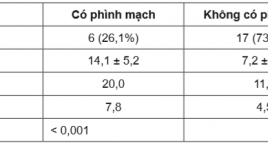
Bước đầu đánh giá hiệu quả điều trị suy tĩnh mạch mạn tính bằng phương pháp đốt laser nội mạch
14/04/2020 22:52:33 | 0 binh luận
Evalation the primary efficacy of endovenous laser ablation in chronic venous insufficiency SUMMARY Objective: To evaluate the efficacy of the treatment chronic venous insufficiency in lower extremity by endovenous laser ablation at Radiology Department in Bach Mai hospital. Subjects and Methods: Prospective cohort on 20 patients with chronic venous insufficiency in lower extremity treated at Radiology Department in Bach Mai hospital from August 2016 to May 2017. Results : The occlusion rate of great saphenous vein was 95,6%, mild complications included ecchymosis (26,1%), pain postprocedure score at 3,4 point (according to VAS). Revised VCSS at 1-month-post procedure was improved evidently (VCSS pre- and post treatment, 8.7±3.0 and 1.9±2.6). Conclusion: Endovenous laser ablation is a mini-invasive and safe therapy, improved clinical symptoms for patients. Keyword : chronic venous insufficiency, endovenous laser ablation.
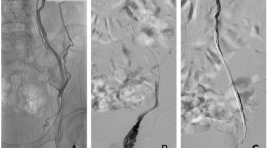
Điều trị giãn tĩnh mạch tinh bằng can thiệp nội mạch sử dụng kỹ thuật SANDWICH tại bệnh viện Bạch Mai
12/04/2020 22:43:19 | 0 binh luận
The treatment of varicocele endovascular intervention using the sandwich technique at Bach Mai Hospital SUMMARY Purpose: Evaluating the result of varicocele endovascular intervention by sandwich technique combining Coils and glue (histocryl). Methods and objectives: 78 patients were diagnosed and treated successfully at Bach Mai hospital from 5/2009 to 5/2017, they were examined, performed semen analysis and ultrasound at before and after 6 months of embolization. Result: The average age of 22.6 years old, the hospitalized reasons is mainly scrotal pain, with 76.9%. After 6 months of treatment, all patients have pain reduction, the pain scores decreased from 6.7 points to 1.2, p < 0.05. Increasing sperm concentration from 10 million/ml to 21 million/ ml, sperm mobility increased from 27% to 55%, p <0.05. Spermatic vein diameter returns to normal limits and have no reflux line after 6 months. No major or minor complications during the intervention and 6 months after intervention Conclusion: Embolization of spermatic vein with technique sandwich combined Coils and glue to treat varicocele is safe and high effective. Key word : varicocele, varicocele endovascular intervention, sandwich technique
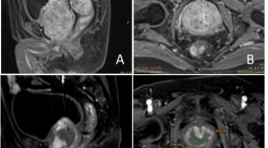
Phương pháp nút động mạch điều trị tăng sinh lành tính tuyến tiền liệt có thể tích lớn: kết quả trên 32 trường hợp (>80 GAM)
12/04/2020 22:28:28 | 0 binh luận
Prostatic arterial embolization for the treatment of benign prostatic hyperplasia due to large: result in 32 case (>80 gam) SUMMARY Background : Currently, large prostate size (>80 g) of benign prostatic hyperplasia still pose technical challenges for surgical treatment with complication such as: hemorrhage, endoscopy syndrome,… Objective : to explore the safety and efficacy of prostatic arterial embolization as an alternative treatment for patients with lower urinary tract symptoms due to large benign prostatic hyperplasia. Methods : A total of 32 patients with prostates >80 g were included in the study; all were failure of medical treatment and unsuited for surgery. Prostatic arterial embolization was performed using combination of 250 μm and 400μm particles in size, under local anaesthesia by a unilateral femoral approach. Clinical follow-up was performed using the international prostate symptoms score (IPSS), quality of life (QoL), peak urinary flow (Qmax), post-void residual volume (PVR), international index of erectile function short form (IIEF-5), prostatic specific antigen (PSA) at 1, 3, 6 month and prostatic volume measured by magnetic resonance imaging at 3 month after intervention. Results : Prostatic arterial embolization was technically successful in 32 patients (100%). Follow- up data were available for the those patients with a mean follow-up of 6 months. The clinical improvements in IPSS, QoL, Qmax, PVR, and PV at 6 month was 74.1 %, 152%, 68.7%, 92.6 %, and 35.5% (3 months), respectively. The mean IPSS (pre PAE vs post PAE 27.5 vs 7.1; P < 0.01), the mean QoL (4.7 vs 1.7; P < 0.01 ), the mean Qmax (7.5 vs 18.9; P < 0.01), the mean PVR (65 vs 20.3; P < 0.01), and PV (98.0 vs 65.0, with a mean reduction of 33.6 %; P < 0.01 ) at 3 month after PAE were significantly different with respect to baseline. The mean IIEF-5 was not statistically different from baseline. No major complications were noted. Conclusions : Prostatic arterial embolization is a safe and effective treatment method for patients with with lower urinary tract symptoms due to large volume. Prostatic arterial embolization may play an important role in patients in whom medical therapy has failed, who are not candidates for any surgical treatment. Keywords : Benign prostatic hyperplasia (BPH), Prostatic artery embolization (PAE), large prostate size

Hình ảnh cắt lớp vi tính và cộng hưởng từ bất thường dây thần kinh ốc tai trên 22 bệnh nhân điếc tiếp nhận bẩm sinh
11/04/2020 22:57:13 | 0 binh luận
CT scanner and MRI imagingof cochlear nerve deficiency in 22 patients with bilateral congenital sensorineural hearing loss SUMMARY Objective: To describe CT scanner and MRI imagingof cochlear nerve deficiency (CND) and cochleovestibular nerve abnormality in association with cochlear aperture, internal auditory canal (IAC) and labyrinthine malformations. Material and Methods : 22 patients with CNDin 43 ears. Aplasia or hypoplasia of the cochlear branch was evaluated on high resolution 3D gradient-echo MRI. Cochlear aperture, IAC and bony labyrinthine malformations was evaluated on high resolutionCT scanner. Results : 22 patients with CNDin 43 ears. Cochlear nerve aplasia in 20 ears (46,5%), cochlear nerve hypoplasia in 2 ears (4,7%), presence of vestibulocochlear nerve with no cochlear branch in 21 ears (48,8%). Labyrinthine malformation in 25 ears (58,1%).The mean IAC diameter 3,03 ± 1,03mm.Cochlear aperture stenosis and atresia 76,7%. Conclusion :CND frequently associated with labyrinthine malformations, cochlear aperture stenosis or atresia and IAC stenosis. Key words : Cochlear nerve deficiency, CT scanner and MRI.
Bạn Đọc Quan tâm
Sự kiện sắp diễn ra
Thông tin đào tạo
- Những cạm bẫy trong CĐHA vú và vai trò của trí tuệ nhân tạo
- Hội thảo trực tuyến "Cắt lớp vi tính đếm Photon: từ lý thuyết tới thực tiễn lâm sàng”
- CHƯƠNG TRÌNH ĐÀO TẠO LIÊN TỤC VỀ HÌNH ẢNH HỌC THẦN KINH: BÀI 3: U não trong trục
- Danh sách học viên đạt chứng chỉ CME khóa học "Cập nhật RSNA 2021: Công nghệ mới trong Kỷ nguyên mới"
- Danh sách học viên đạt chứng chỉ CME khóa học "Đánh giá chức năng thất phải trên siêu âm đánh dấu mô cơ tim"

